
Surcotes
The Outer Layers: Overgowns, Surcotes & Sideless
Surcotes
SURCOTES - SLEEVELESS OR SHORT-SLEEVE SURCOTES
- SIDELESS SURCOTES
FURRED SIDELESS SURCOTES - JEWELLED BANDS - HERALDIC SURCOTES

Surcotes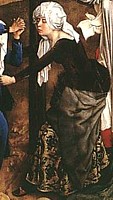
A surcote is the garment which is an outer gown. It comes
in three basic styles.
One is relatively fitted and has short or long sleeves and looks
exactly like the gown that is underneath. This is a plainer gown
which is worn over the more elaborate undergown or kirtle which
was usually made of a better fabric. In many artworks this is
what looks like the main dress, when in fact, there is another
underneath it.
Seen at right in the detail
from the centre panel of the 1445 Van Der Weyden painting the
Abegg Triptych which shows the surcote or over-gown lifted
to reveal the sumptious 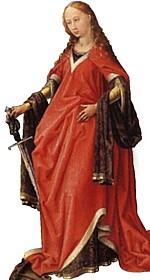 undergown
or kirtle. undergown
or kirtle.
The second is a volumnous, loose overgown worn as an outdoor gown
for work or travel. In the 15th century, iIt sometimes had a V
neck and shorter sleeves, although often it had long sleeves.
In artworks it is shown either lose or belted under the bust.
Shown at right is a detail from the right panel of one of Van
der Weyden's Diptychs from 1440. This surcote is actually
the fourth layer of clothing over the woman's chemise, kirtle
and overgown. In the image the gold-coloured kirtle sleeves and
the darker coloured over-gown sleeves are visible with the red-coloured
surcote over all of the layers.
The third is an overgown with the sleeve sides which might be
absent or cut low and wide. Records and contemporary accounts
can be confusing as dress terms vary and over-gown, gown
and surcote can mean different garments at different times
or in different countries.

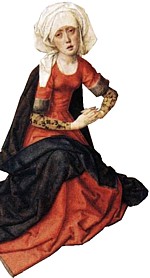 Overgown
Surcotes Overgown
Surcotes
In the detail at left from the 1460 painting by Bouts, The
Lamentation of Christ, we can see a surcote which may be waisted
and has three-quarter length sleeves which have been folded up
the arms. Underneath, her patterned kirtle is visible.
We know that this is different to pin-on sleeves because the surcote's
sleeves are over it, whereas the pin-on sleeves we see
in other manuscripts go over the top of the other sleeve
or can be seen actually pinned onto it.
The habit of hitching up the outer gown to show off the more expensive
fabric underneath was very widespread amongst women, whether European
or English. Many contemporary paintings of women sitting show
the outer gown folder back.
It appears that a great number of these were fur lined, although
not all. It is reasonable that in the height of a European winter,
that a gown lined with fur would provide the necessary warmth.
In summer, however, it follows that lighter fabrics were used
and for the poorer women, be unlined. A woman might own several
surcotes.

Surcotes
or overgowns with hanging sleeves
Shown at right is a detail from a manuscript showing a woman wearing
an overgown or surcote which has hanging sleeves and is fitted
like the dress underneath.
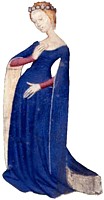 Surcotes
with hanging sleeves were popular in the early 14th century and
again in the early 15th century. In some cases, where just the
lining of the hanging sleeves are seen, they are mistaken for
furred tippets. This image shows clearly that in this case, the
hanging part is actually the sleeve of the outer garment. Surcotes
with hanging sleeves were popular in the early 14th century and
again in the early 15th century. In some cases, where just the
lining of the hanging sleeves are seen, they are mistaken for
furred tippets. This image shows clearly that in this case, the
hanging part is actually the sleeve of the outer garment.
In their book Women In The Middle Ages, Frances and Joseph
Gies discuss the wardrobe of Italian woman Margherite Datini,
the wealthy wife of a businessman in the 14th century.
It lists only two gowns and 11 surcotes in 1397, two of which
she had in 1394 and still possessed. Her wardrobe included purple
lined with green, blue damask trimmed with ermine, camlet (camel's
hair and angora) lined with pale blue taffeta, ash-colour bordered
with miniver, Oriental damask and aristocratic old rose. She also
had a heavy overcoat of heavy silk, which was full-cut to the
floor. It is noted that the cut and style of these garments varied
greatly with some requiring twice the amount of fabric as some
others.
One imagines that the closer cut ones were worn at home during
domestic duties and the more ostentatious garments worn for social
occasions. It also appears that as well as being thrifty with
her clothing, it was acceptable for a woman of good breeding to
keep and wear outer garments for more than a year or two like
we do with a winter jacket today. It also appears that the number
of surcotes owned by that of our model woman, Margherite, was
not seen to be excessive.

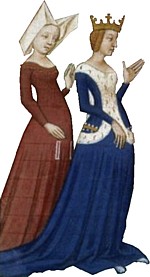
Fichets,
not pockets
In many cases, fitchets or fichets were utilised
in the front of the gown.
Looking
very much like edged pockets, we know that they were not.
Fitchets were small slits in the front of the gown for the hands
to pass through so that they might access the pouches hanging
on the belt below. The belt is worn on the kirtle underneath,
not on the top layer. This deterred theives from cutting the strings
on the purse handing from the belt and kept the woman's valuables
safe.
They can be seen in the pink dress in the detail of the illumination
at left from the 15th century manuscript Guiard des Moulins
Bible Historial, along with a sideless surcote with ermine
trim around the side openings but not the hem.

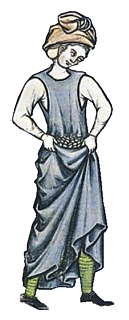 Sleeveless
or Short-sleeve Surcotes Sleeveless
or Short-sleeve Surcotes
This is the garment is an outer sleeveless gown which falls into
two categories- for the working class and for the upper classes.
It is a looser fit and can either have a regular neckline, be
slightly gathered onto a decorative band or have a loose V shaped
neckline and three-quarter sleeve. If sleeveless, the sleeves
are usually high cut just under the armpits.
A working class woman would wear a surcote like this to protect
her clothes underneath from excessive wear and dirt.
Shown at left is a detail from Ruth Threshes Grain For Naomi
from the 13th century Maciejowski Bible wearing a surcote with
high armholes. The bible is often known as the Morgan Bible, and
shows numerous scenes of domestic life including clothing worn
by regular people. Of note is Ruth's striped hose which would
normally remain unseen under her surcote.
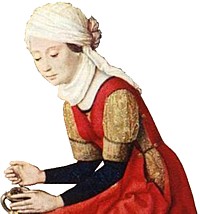 An
upper class woman might wear a sleeveless or short-sleeve surcote
for warmth or when traveling.Many illuminations and paintings
clearly show linings in contrasting colours. In a few paintings
of working women, the garments do not appear to be lined. Considering
the cost of fabric, a general rule of thumb is that the more well
off a woman, the more likely her garments were lined. An
upper class woman might wear a sleeveless or short-sleeve surcote
for warmth or when traveling.Many illuminations and paintings
clearly show linings in contrasting colours. In a few paintings
of working women, the garments do not appear to be lined. Considering
the cost of fabric, a general rule of thumb is that the more well
off a woman, the more likely her garments were lined.
This type of gown is often shown with side seams which were laced
to allow for an expanding waistline of a young pregnant mother.
Shown at the right is a detail from 1464 - 1467 Bouts painting,
The Gathering of the Manna, which shows an unusual surcote
with a side fastening. Usually, side fastenings are laced.

 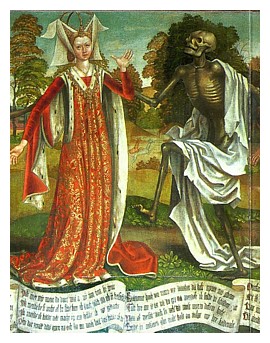 Sideless
surcotes Sideless
surcotes
Sideless surcotes were designed to show off the gown underneath
and were quite different to the utilitarian kind of surcote worn
in the country to protect clothes or those worn by the upper classes
for warmth when raveling.
They could be cut from underarm to hip, or as the image detail
at left shows from the 1345 Paris manuscript, Romance of the
Rose, can be cut much lower.
They have no band of buttons or jewels down the front and are
often very plain-looking with a minimum of embroidery at the very
outer edges of the opening or with none at all.
Very usually,
these are made from plain material, but in the 15th century detail
from The Dance of Death shown at left, we see an unusual
brocade surcote over a velvet kirtle. It had a V neck, which is
a design usually seen in 15th century paintings and it is trimmed
in ermine at the sides and hem. This type of garment is likely
to to fur-lined throughout.

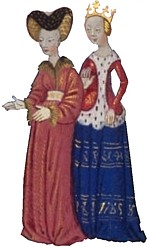 Furred
Sideless Surcotes Furred
Sideless Surcotes
This style of surcote was described as the gates of hell
by one particularly cencorous preacher because the wide, low-cut
sides showed off the more formfitting undergown or kirtle. This
clearly, would lead men into temptation, and therefore, the gates
of hell itself.
The upper half is entirely
furred, very often with ermine for those who could afford it and
were socially able to wear it. Sumptuary laws attempted to regulate
what kinds of furs might be worn by which class of person, often
with little success.
This style was most popular with fashionable ladies and nobles
who could afford showy displays of expensive fur trimmings or
gold embroidery. It would neither have been practical as a protective
garment or warm due to the openings at the sides for the lower
or working classes. If a belt was worn, it was never worn over
the top of this garment, but low on the hips of the gown underneath.
In many illustrations, the belt is barely visible or not visible
at all.
The image at right shows
an illumination The Madness of Lancelot showing a gold-embroidered,
cloth bottom and furred top.

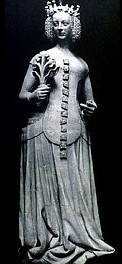 Jewelled
bands Jewelled
bands
The top section of these garments were furred and often they were
lined with fur also. The arm openings were frequently cut right
to the widest part of the hips. Many top halves had a decorative
and elaborate jeweled band or buttons.
The statue of Jeanne De Bourbon at right dates from 1390 shows
a very long, jewelled band down the front of her sideless surcote.
I have read that the band
was designed to be removed or that the metal squares or large,
jeweled buttons were stitched onto a separate vertical band, which
certainly makes sense for cleaning, but having made a replica
of this outfit, I found the band which was metal to begin with
and further set with semiprecious gemstones and freshwater pearls,
to be extremely heavy to suspend from the top alone with no other
support.
  Close-ups
of Jean de Bourbon's and Isabella of France's surcotes show better
details of their jewelled bands but shed no real light onto how
they were attached. They show a similar style of ornamentation-
a lozenge shape in the centre surrounded by what are probably
pearls or jewels. Close-ups
of Jean de Bourbon's and Isabella of France's surcotes show better
details of their jewelled bands but shed no real light onto how
they were attached. They show a similar style of ornamentation-
a lozenge shape in the centre surrounded by what are probably
pearls or jewels.
The image on the right shows what looks like a buckle across the
band, possibly for securing purposes.
It is very difficult to tell
whether these are secured individually or as one band, although
it is generally accepted that it is one band with the individual
segments either joined together or attached to a separate band
which could be removed for cleaning.

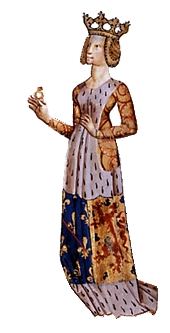 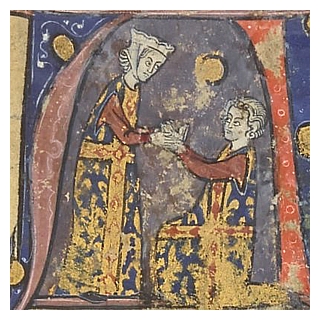 Heraldic
Surcotes Heraldic
Surcotes
Occasionally, the surcote is shown as a heraldic garment, although
not very often- that is, one with the coat of arms of the family
of the wearer.
The rule for the placement
of the heraldic design for clothing of this type, is that when
the garment is seen face on, it replicates what one would see
on the shield.
The entire design is duplicated
on the reverse of the garment. The designs do not wrap around
the wearer.
At right, a heraldic surcote
from The Romance of The Pear, a 13th century manuscript
where characters are shown throughout the manuscript, both male
and female, wearing heraldic surcotes. The family whose arms it
is has not to date been identified.
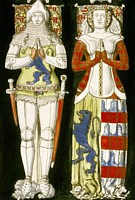 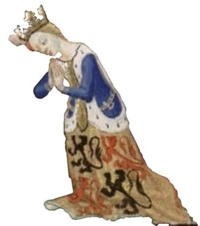 The
colourised image on the left shows a line drawing from a brass
plate dated 1395 of Hugues de Roucy and his wife. His own arms
are clearly seen on his own clothing, and her own family device
is halved with that of her husband on her sideless surcote. The
colourised image on the left shows a line drawing from a brass
plate dated 1395 of Hugues de Roucy and his wife. His own arms
are clearly seen on his own clothing, and her own family device
is halved with that of her husband on her sideless surcote.
A noble lady who came from
a family of reknown would not give up her own family affinity.
This would depend on the families and was not a blanket rule for
all heraldic clothing.
The detail of the image shown
at right shows Queen Phillipa of Hainault from a 15th century
manuscript by Jean Froissart. Her arms are on the lower of her
ermine-trimmed sideless surcote.

Copyright
© Rosalie Gilbert
All text & photographs within this site are the property of
Rosalie Gilbert unless stated.
Art & artifact images remain the property of the owner.
Images and text may not be copied and used without permission.
|